The Apple iPad Mini 4 Review
by Brandon Chester on October 28, 2015 8:00 AM EST- Posted in
- Tablets
- Apple
- Mobile
- iPad Mini 4
Display
When the original iPad Mini launched it came with a 7.9" 1024x768 IPS display. The third generation iPad had already existed for nearly eight months at that point, and so the display was a notable step down from the full size iPad. However, in order to drive its display the iPad 3 had to include a massive 42.5Wh battery, and was both thicker and heavier than the iPad 2 that came before it. There was simply no way to include such a display on the iPad Mini at that time.
A year went by, and Apple then launched the iPad Air and the iPad Mini 2, both of which had 2048x1536 IPS displays. Based on their specifications, one would think that the iPad Mini 2 was simply a shrunken down iPad Air. However, there was one caveat, which was the iPad Mini 2's color gamut. In order to drive down power consumption the iPad Mini 2 used an LED backlight array which didn't have the necessary spectral range to cover the sRGB color space, which gave it more muted colors than what one would see on the iPad Air's display. The following year came and went, with the iPad Mini 3 only adding Touch ID to the iPad Mini 2. At that point I began to wonder when we would finally see parity between the displays on the smaller and larger iPads.
This year's iPad Mini 4 appears to be the version that finally addresses the gap between the displays on the mini and normal size iPads. Apple claims that it has full coverage of the sRGB color space, along with the anti-reflection coating and display lamination that debuted on the iPad Air 2. Of course, anyone who has followed my tablet reviews knows that covering a color space doesn't guarantee accuracy of the colors within that space, and to examine the accuracy of the iPad Mini 4's display I've run it through our standard display testing workflow. As always, the display is calibrated to 200 nits, and measurements are performed with an X-Rite i1Pro 2 and managed with SpectraCal's CalMAN 5 software.
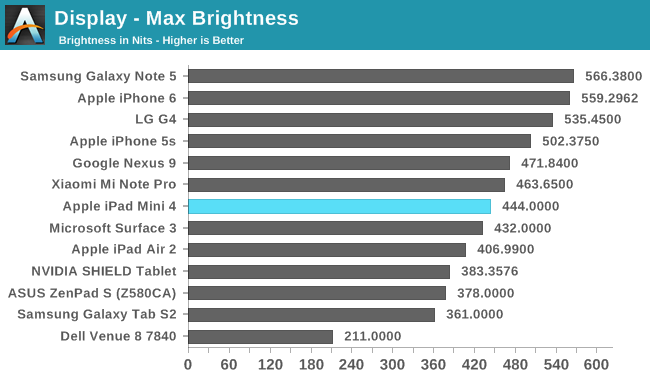
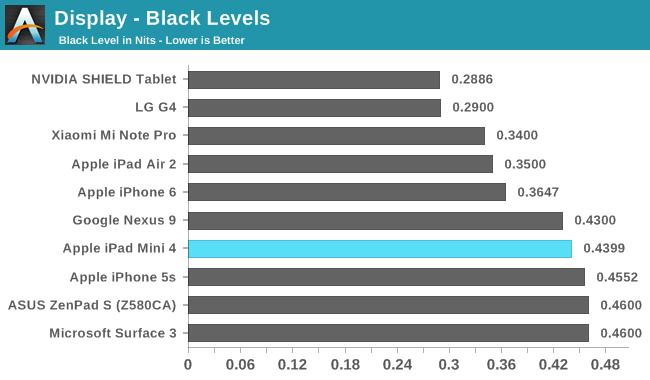
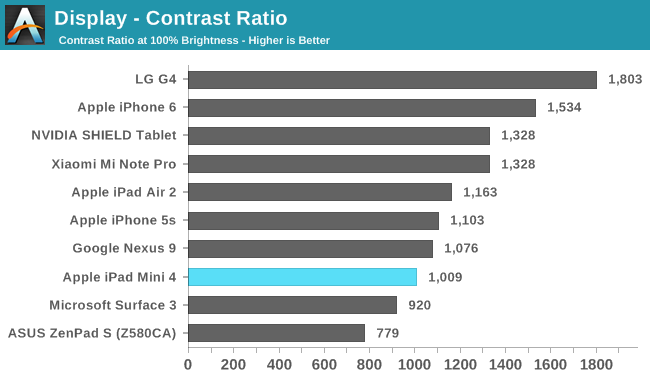
Peak brightness is surprisingly high on the Mini 4. I expected it to be more in line with the Air 2, but it's actually significantly brighter. Along with that comes higher black levels at max brightness, although if you put both at the same brightness the black levels are fairly close. The contrast ratio for the Mini 4 does fall a bit below that of the Air 2, and neither are in the same class as newer IPS LCDs on phones like the LG G4 and recent iPhones that use photoalignment to influence subpixel orientation in order to boost contrast. However, both are in line with the best you'll get on tablets without moving to an AMOLED panel with true blacks like the one on the Tab S2.
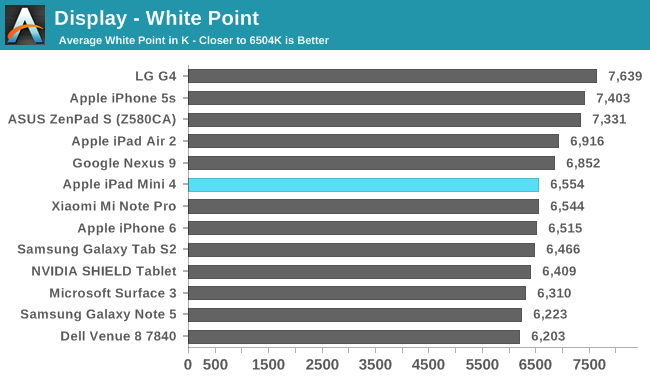
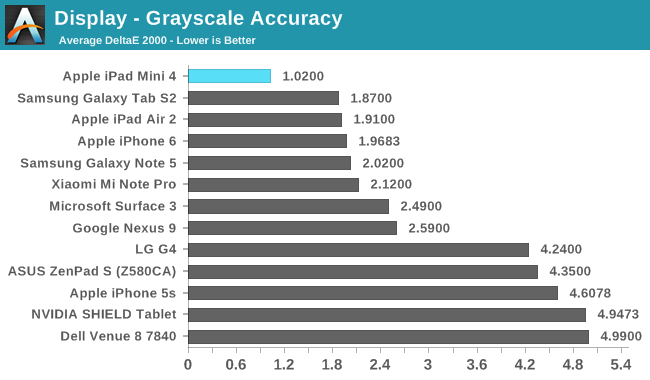
Greyscale accuracy on the Mini 4 is superb, and with almost every shade there's no way to see any errors. Once you hit 80% grey and above there is an ever so slight green tint, but it's nothing that you would really notice during everyday use, and error for the critical 100% white value is almost impossible to perceive. Gamma is also remarkably straight, and the average white point is only ever so slightly blue. I think that my unit actually tends less toward the blue than the average unit will, as in my experience iOS devices sit somewhere closer to 7000K than D6504 as the WLED backlights are more energy efficient when the display is calibrated to be slightly blue.
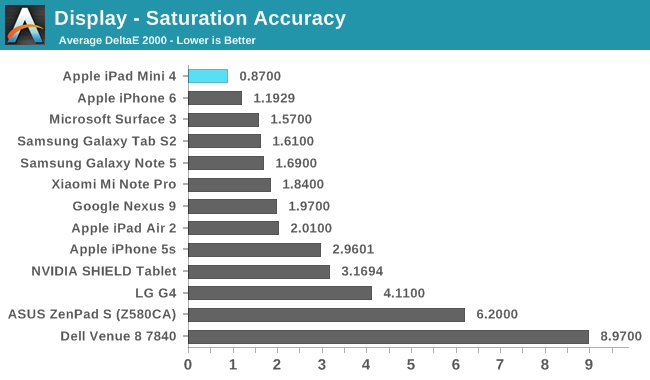
On my unit there's actually no way for the human eye to discern the difference between any of the measured saturations and the actual reference value, even if you were to put those two colors side by side. I can't imagine that this is true of all models, as achieving this level of calibration across every Mini 4 is simply not feasible. That being said, even if some Mini 4 had saturation errors that were three times higher than my result it would still be a great display and in most cases you wouldn't notice any visible errors.
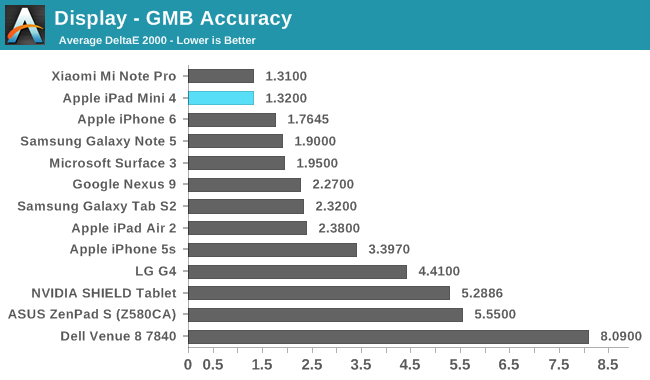
The Mini 4 shows an extremely high degree of accuracy in the Gretag-Macbeth ColorChecker test, with only a couple barely noticeable errors in shades of orange. Again, I think my unit is probably one of the better ones out there, but if the average unit is even remotely close to this then it's going to have a very accurate display for essentially any color within the sRGB gamut. There's really not much more to say, as I can't find anything about the Mini 4's display that I could honestly criticize.


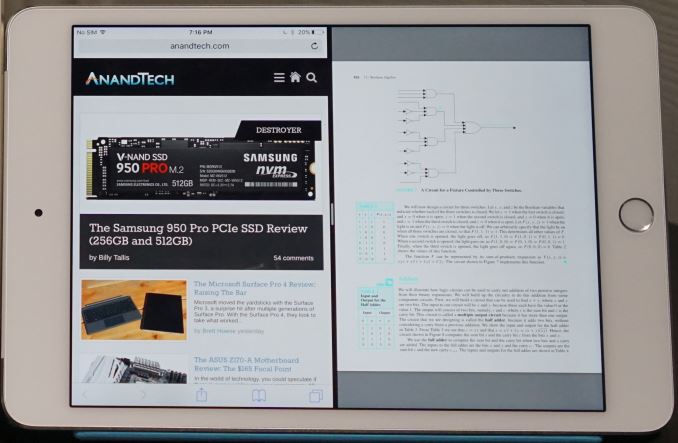



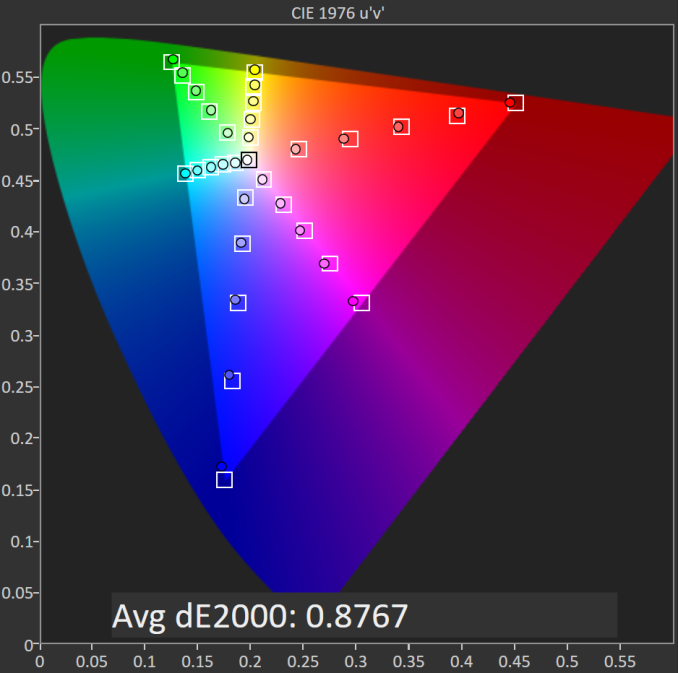
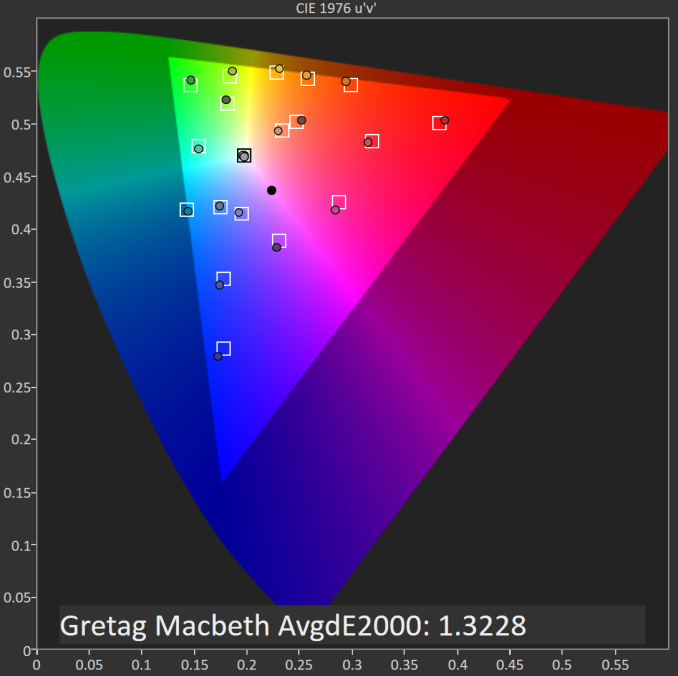









98 Comments
View All Comments
Speedfriend - Wednesday, October 28, 2015 - link
Any idea why this uses the 8 and not the A8X? Does that imply the chassis is not capable of dissipating the higher TDP of the A8X?michael2k - Wednesday, October 28, 2015 - link
I imagine they would have needed a bigger battery to offset the performance cost of the faster GPU and additional CPU core. Throw in a bigger battery and you have to make the iPad a fractional bit thicker, maybe 0.7mm, and another 14g heavier.And throw those three changes (more expensive CPU, more expensive battery, heavier iPad) and you need to bump the cost up just slightly, reducing margins just slightly, on top of the changes in the display that already increase the cost, and it makes sense why they sacrificed performance slightly. This is especially true when the A8 is already and still class leading a year later.
ThomasS31 - Wednesday, October 28, 2015 - link
This has nothing to do with cost... its just a decision to keep everything as thin and light as possible to appeal to the fans and consumers.Ivy said not long ago, they could make a thicker iphone to last longer (battery), but they do not want as it will not appeal as much to the consumers as the current thin phones.
Nothing to do with cost or price... just a decision, some of us like, and some of us not. :)
michael2k - Wednesday, October 28, 2015 - link
None of the outward justification is cost, of course, but they have to hew to a budget like everything else in the world. They increased the cost of the SoC, the memory, the cameras, and the screen, as is. Throwing in the more expensive A8X, the battery for said A8X, and the thicker shell to support both means they would have, as you said, lose the design goal of thinner and lighter. So there would be three reasons to stick to the A8:1) Thinner
2) Lighter
3) Cheaper
GC2:CS - Thursday, October 29, 2015 - link
Considering how energy efficient the Apple chips are, het deffinitelly isn't a problem.You has A8, even if a bit underclocked in an 6,1mm iPod touch. There it can almost perfectly sustain it's peak 1,1 Ghz CPU clock and GPU performance. iPad mini is just a much bigger device, there is more than enough room to dissipate heat, even if it would mean an A8X has to throotle a bit more aggressively than in Air 2.
A8X is a three billion transistor monster, it's big, it's pricey and since it's an X there is no stacked memory on it. That might be the reason - all iPad minis used PoP to save space and so I think that a possibility of an X chip in any iPad mini is quite small.
Also it uses a quite lot of power. If you look at that Gfx bench battery life test above, maybe Apple wanted to match them in terms of battery life under load.
And then while mini might be cappable of dissipating enough heat, Apple possibly didn't wanted the temperatures to go that high. iPad mini 4 is found to be rather cool running even under load.
But I doo agree that an A9 would be much better match. Even though it doesn't have 128-bit memory interface (What has it by the way ?) it bassically matches the performance of A8X, while being much smaller and lower powered, much more efficient than even A8.
Apple said that it's an shrunken down iPad Air 2. In terms of battery life, features, design, cameras display yes.
But with smaller size (and less matter to built a tablet from) there has to be compromise somewhere. Apple didn't matched the performance of Air 2, because it would require more advenced tech (A9) to do so in smaller device. But that would make it more advanced than an shrunken down Air 2 in terms of used tech. Bassically they built the best small tablet possible with let's say the same genertion of technology as iPad Air 2.
iPad mini 2 got smaller color gamut, iPad mini 4 got lower performance. And unless Apple invents a way to make those devices bigger from the inside, they can't defy physics.
Pneumothorax - Thursday, October 29, 2015 - link
Here's the thing, the A9 would've been an easy drop in the Mini 4 and would've matched/exceeded the Air 2 in most benchmarks along with giving better battery life and much less heat. Apple is just being Apple - milking the cow for all it's worth.NetMage - Saturday, October 31, 2015 - link
The mini's considerable price drop versus the Air or phone means giving up something.Drumsticks - Wednesday, October 28, 2015 - link
Thanks for the review. I always enjoy reading Anandtech reviews of Apple products. While I'm an Android/Microsoft guy (any hints on when to expect your 6P review? I'm sure it's a ways off but I'd love a hint!), I have a lot of respect for Apple's hardware engineering and SoC design teams. They do really, really great work, and it almost disappoints me that I dislike iOS (and to an extent, Apple. This is an opinion that is fully subjective and not looking to start a fight! There's plenty of reasons to like Apple).Apple has, for the last several years been a major driver of innovation in the whole industry, which is great. It's awesome to see (in my opinion) both Microsoft AND Google doing the same nowadays. All three of the big guys are driving the industry forward, and it's good for us all :D
amdwilliam1985 - Thursday, October 29, 2015 - link
Same here, I recommend Apple products to others(my parents and my brother all use iPhones), but when it comes to personal device, I'll go with Android/Nexus, will be picking up a Nexus 6P soon, when it's available in Hong Kong.ps: Personally, I want to support Google/Alphabet, don't want to give my money to Apple and then have it sit in their bank doing nothing(besides earning interests ;). It's just a personal believe, I believe with great power comes great responsibilities(Apple should be doing more to help the [tech] world). Luckily, there are always companies like Google who pushes on with crazy projects like Project Loon, Project Fi, Project Soli, Project Jacquard and etc...
I watch Apple WWDC and Google IO live every year, Google's event is just so much more exciting and inspiring to the tech geek in me. Apple's show is more about how they are the best and if you can't join them, then you're a loser kind of show, lol.
Knowing my money helps Google to help improving the world/tech helps me sleep better at night, lol.
lucam - Wednesday, October 28, 2015 - link
The A8 is still a good decent Soc from what I can see and I have a suspicion that in the Apple TV for not having similar thermal constrains and no battery it can go even faster...